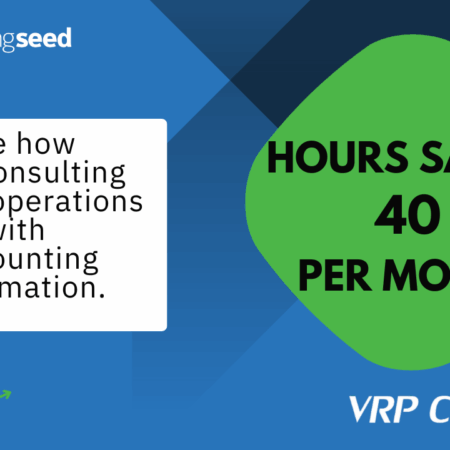
Accounts Payable (AP) automation is the use of technology to digitize and optimize the invoice-to-payment process within an organization. Software that automates AP can capture invoice data automatically, route bills through approval workflows, process payments electronically, and reconcile transactions—all while maintaining human oversight at key decision points.
This technology addresses a major drain on finance teams’ resources: the manual, repetitive work that consumes hundreds of hours annually. For AP teams, this means freeing up time to focus on strategic work while gaining better control over the entire payment process.
“By bringing in an automated solution, it decreases those manual steps and allows teams to process more invoices while saving money and improving cash flow,” explains Jennifer Fennell, Manager at Accounting Seed. “It also increases accuracy—you’re not typing in the same information over and over again. The efficiency gains and improved accuracy are significant.”
The technology enables more strategic approaches to vendor payments. For instance, imagine if your finance team could systematically evaluate which bills to pay when—prioritizing rent, capturing early payment discounts, and managing vendor relationships—then bundle recommendations for management approval. By automating AP workflows, organizations gain real-time insights that were previously delayed by manual processing.
“There’s a big reporting and analytics benefit here,” adds Shannon Canzanella, Manager at Accounting Seed. “C-suite leaders rely on real-time visibility into cash flow to forecast spending, plan for growth, and make faster decisions.”
While 63% of U.S. companies have partially automated AP processes, fewer than 20% are fully automated, and 14% still use mostly manual processes—creating significant opportunities for small and mid-sized businesses to gain competitive advantages through improved efficiency and financial control.
Understanding the AP automation process and workflow
AP automation tools typically include the following features, with a workflow that streamlines the process from invoice capture to reconciliation, though specific offerings and workflows will vary from provider to provider:
Invoice Capture: Invoices enter the system either by email or manual upload where key data like vendor names, invoice amounts, and due dates are automatically extracted using OCR or AI. Solutions that offer advanced AI technology go beyond basic text recognition, learning from previously processed invoices to predict how to populate key fields like general ledger accounts and project codes.
Invoice Coding: Instead of manually assigning general ledger codes, the system uses AI to suggest GL accounts based on previous inputs.
Approval Routing: If you’ve set up rules, Invoices are automatically routed to the right approvers based on rules like department or amount thresholds. Some systems also allow for strategic payment bundling, where AP staff can group bills together then send these payment proposals to management for approval.
Payment Processing: Once approved, payments are processed through the system using methods like ACH, virtual cards, or paper checks. Credit memos are applied where needed.
Reconciliation: Payments are matched to bank transactions and cleared automatically—there’s no need to do reconciliation manually.
Automating workflows eliminate the tedious aspects of AP while maintaining human control at every approval point. All in all, manual invoice entry is declining—in 2023, 85% of invoices were still being keyed in by hand. In 2024, that number dropped to around 60% as scanning and e-invoicing tools became more widely adopted.
Top benefits of AP Automation
Companies that adopt AP automation see real, measurable results—both in cost savings and strategic benefits.
Speed up invoice processing by 82%
Best-in-class organizations process invoices in just 3.1 days, compared to 17.4 days for others—an 82% improvement in speed attributed to increased automation and AI-driven workflows. In addition, top-performing AP teams report invoice exception rates of just 9%, compared to around 22% in departments that still rely on manual methods, boosting operational efficiency.
Reduce your per-invoice cost by 70%
Automation delivers major cost savings. Manually processing an invoice costs around $10.18 on average. With automation, that drops as low as $3.12 per invoice—a 70% reduction.
Cut down on AP errors by 50%-80%
Automation eliminates roughly 50%-80% of invoice processing errors by removing manual data entry mistakes. These errors typically stem from simple mistakes: typos that turn a $1,200 invoice into $12,000, duplicate payments to the same vendor, incorrect general ledger coding, or mismatched purchase orders.
Optimize your spend
Automation lets finance teams plan payments more strategically, capturing early-pay discounts while avoiding costly late fees. One study found that 95% of companies with fully automated AP saw improved accuracy and efficiency in their payables process, translating into better working capital management.
“There’s two sides to that coin,” explains Fennell. “Taking advantage of early pay discounts is one thing, but avoiding late payments is just as important. If you’re paying bills late, you’re paying a hefty fee and that’s a waste of money.”
Strengthen vendor relationships
Timely, consistent payments improve supplier relationships and can lead to better terms in future negotiations. When vendors know they’ll be paid on time, it builds trust and strengthens partnerships.
“If you were to pay late to a key vendor that you rely on, that would be a big disadvantage to your relationship,” adds Canzanella. “By paying early or on time, it increases the trust between partners and vendors.”
Speed up cash flow and achieve real-time visibility
Faster invoice processing has follow-on effects. When you know exactly what’s been paid and what’s pending, you can make strategic decisions about cash allocation, timing new investments, and managing working capital more effectively. This real-time visibility helps leadership make informed decisions about spending, budgeting, and growth investments without waiting for delayed financial reports.
“Not having timely insight into what needs to be paid and what’s owed can put you at a real disadvantage and hinder your ability to jump on opportunities as they arise,” notes Canzanella.
Embedded vs. bolt-on AP automation solutions
When it comes to choosing an AP automation solution, it’s helpful to understand the difference between bolt-on and embedded finance solutions.
Bolt-on solutions: Bolt-on solutions, like those offered by some payment processing companies (such as Bill.com), require you to integrate multiple systems. This often means manually entering data into your general ledger and then using a separate system to process payments. These solutions can work, but they add complexity and potential for errors.
Embedded solutions: On the other hand, embedded AP automation is directly built into your accounting software. With an embedded solution, everything happens within one system—you don’t have to leave the platform to match invoices, create payment proposals, get approvals, or do reconciliations. This integration reduces errors, saves time, and gives you real-time visibility into your finances.
“You don’t have to log into a different system to process bills,” explains Fennell. “There’s a serious efficiency and accuracy benefit here.”
“No syncs needed. It’s a simplified tech stack when you have everything all in one system. No delays, mistakes, or pushing data between systems,” adds Fennell. “Reconciliation is done for you. It gives you a real-time picture of what’s actually in your accounts.”
AP automation implementation: What to consider
Rolling out AP automation doesn’t have to be overwhelming. With the right plan, it can be a smooth transition.
Step 1: Prepare your data and processes: Clean up vendor records and document current approval workflows. Ensure your chart of accounts is organized and ready for automated coding.
Step 2: Plan your rollout strategy: Start with a pilot group or specific vendor types before full deployment. Set up approval hierarchies and payment thresholds in the system.
Step 3: Train your team: Provide hands-on training for AP staff on new workflows, from invoice capture to payment processing. Ensure approvers understand the new digital approval process.
Step 4: Monitor and optimize: Track key metrics during the first few months, gather feedback from users, and adjust automation rules as needed to improve efficiency.
What ROI will you see from automating your AP?
AP automation isn’t just a cost-saver—it’s an investment that pays off quickly:
- Lower costs: Many businesses cut processing costs by over 70%
- Fast payback: Studies show 158% ROI and payback periods of less than six months
- Better working capital: 98% of executives believe they could have more confidence in their cash flow, and automation provides the real-time insights they need
- Less risk: Audit trails, fraud prevention, and compliance checks are all built-in
“The use of AP automation really impacts the way your leadership is able to forecast and plan what you need to do in sales, what you have budget for in marketing—it impacts all of that,” says Canzanella.
What you need for AP automation to deliver top value
For AP automation to work as it should and deliver the most value, all components of your financial workflow need to exist in the same platform.
Consider this scenario: a vendor invoice arrives that needs to be coded to specific departments, cost centers, or general ledger accounts. Without embedded AP automation, your team relies on separate OCR tools to scan invoices, external payment processors to handle disbursements, and manual processes to match everything back to your accounting system. Each disconnected tool introduces potential errors, requires manual reconciliation, and defeats the purpose of automation.
For Salesforce users—or those planning to use Salesforce, which many companies choose because it’s the leading CRM platform in the world—Accounting Seed offers a better approach. Our accounting software is built natively on Salesforce—meaning there is no integration required to sync sales and accounting information. We also offer fully embedded AP automation, eliminating the sync delays and data inconsistencies common with bolt-on AP solutions.
“That’s what sets Accounting Seed apart,” explains Fennell. “You don’t have to log into another system to pay your bills. There’s no need for syncing—it’s all right there in one place.”
Advanced features in Accounting Seed like AI Invoice Capture extend AP automation features beyond basic text recognition by learning from previously processed invoices to predict how to populate key fields like general ledger accounts, products, and project codes—getting smarter with each use.
A unified platform with embedded AP automation approach several key advantages:
- Shared data: Sales, financial, and operational data is housed together on a single platform, enabling accurate and seamless automation
- No integration delays or issues: Approved payments and reconciliation happen in automatically within your existing platform
- Simplified tech stack: Eliminate the complexity of managing multiple systems and their connections
- Better visibility: Finance teams see expenses as they happen and understand cash flow impact immediately
The result is a unified workflow where sales data automatically flows into accounting, invoices get processed without leaving the platform, and financial reporting reflects real-time business performance.
Frequently Asked Questions (FAQs) about AP automation
What is the primary goal of accounts payable automation?
The primary goal is to eliminate manual, time-consuming tasks in the invoice-to-payment process while improving accuracy, speed, and financial visibility. AP automation aims to reduce processing costs, minimize errors, and free up finance teams to focus on strategic activities rather than repetitive data entry.
Can AP automation integrate with my current system?
Yes, but embedded payments offer a more seamless experience than bolt-ons. With embedded solutions, there’s no need for connectors or separate logins.
Will this help with cash flow management?
Yes, AP automation improves cash flow management. Real-time visibility helps you plan spending, avoid late fees, and make informed decisions faster.
What does it mean for vendor relationships?
Faster, more consistent payments improve trust and reduce friction. Better relationships often lead to improved terms and stronger partnerships.
What should I look for in an AP automation tool?
Look for embedded data capabilities, flexible payment options, strong controls, and scalability that grows with your business.
AP automation converts invoice processing from a slow, manual task into a faster, more accurate, and more strategic function. It reduces costs and errors while giving finance teams better visibility and more time for high-value work.
If you’re ready to make AP easier for your team, Accounting Seed offers a native Salesforce solution that handles the entire process—from invoice capture to payment reconciliation—all embedded in one place. Learn how Accounting Seed can help streamline your accounts payable process.
See Accounting Seed in action
See how accounting on Salesforce can eliminate the need for costly integrations—and silos of mismatched information—by sharing the same database as your CRM.



